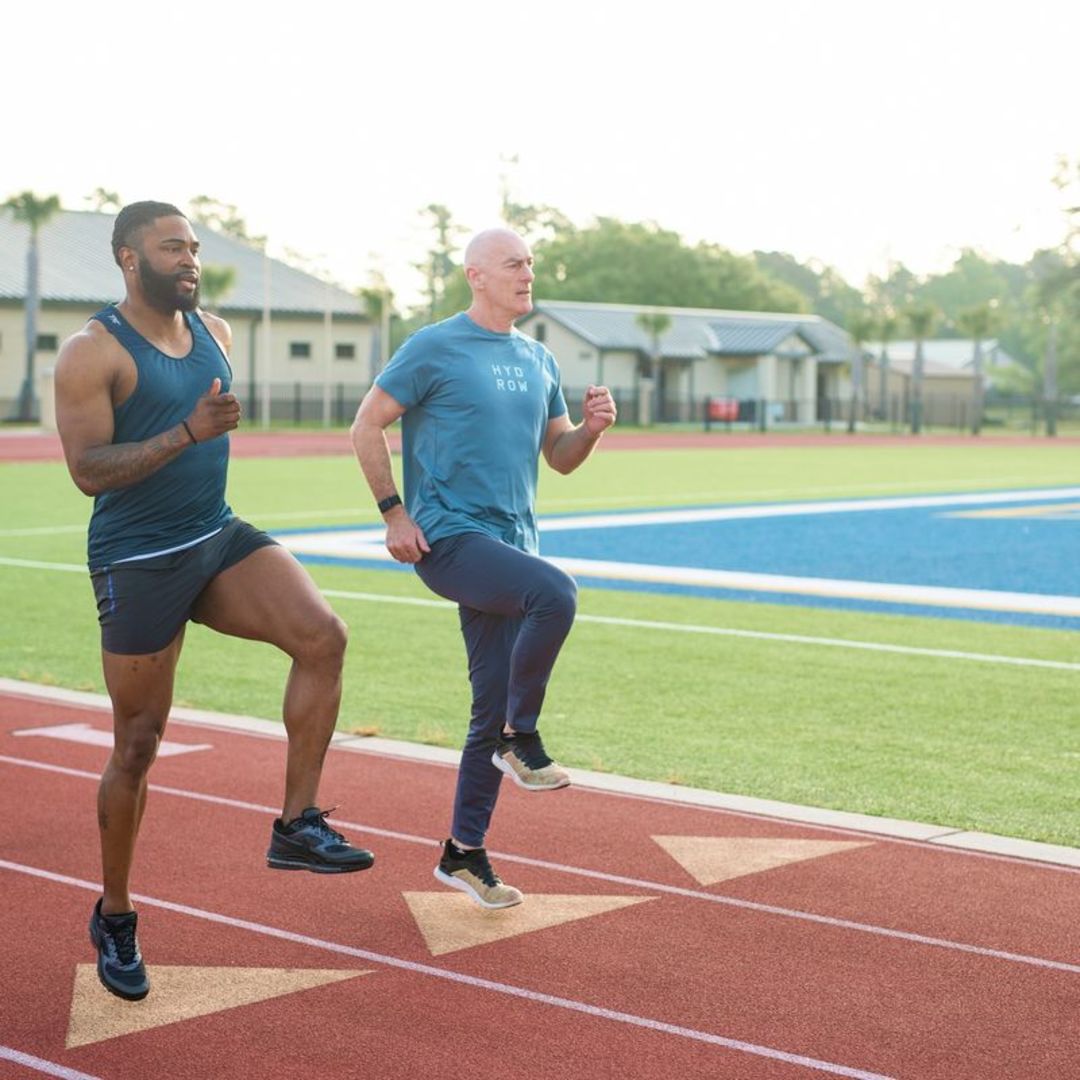How to Get Back Into Working Out After a Long Break

So, you’ve had a long break from working out and want to get back into an exercise routine. Welcome to the comeback club! You are definitely not alone — everyone who has ever worked out for any length of time has also had periods where they have been unable to work out. It goes with the territory!
Whether you had to step away from exercise due to injury, lack of motivation, or life circumstances, know that it is something all of us have had to do.
So, let’s look at how to get back into working out, what’s the best approach to regaining fitness, and some of the pitfalls that can hinder your big comeback (and how to avoid them!). Here are six best practices to get from where you are to where you want to be, including:
Let’s get started!
1. Find workouts that are engaging and motivating
No matter what your motivation to work out is — whether you’re aiming for better overall health or preparing yourself for an event — you will ultimately be spending a lot of your time exercising. So, make sure you find something you enjoy!
It may sound cliche, but you have to enjoy your journey. Liking what you do will not only make your workouts more fun, but it will also make it more likely you will come back time and again, even when you aren’t at your most motivated.
Trying to decide which workout to do? Look at what you’ve done in the past — did you derive some enjoyment from your exercise, or was it just a grind and a means to an end? If it’s the latter, it may be time to look for a new workout or introduce a new type of workout as part of your overall plan (see step six for more on workout plans!).
2. Experiment with different types of workouts
As you start to plan your big return, first take some time to look at how you worked out previously and what you see yourself doing now as you regain your fitness and strength. Does it have to be the same? Would you be interested in trying something new? As you begin again, it’s a great time to experiment and potentially discover a new love for a different type of workout.
There are many great reasons to do this aside from the pure joy of exploring a new activity. For example, if your former workout routine resulted in an injury that kept you away from exercise, adding to (or replacing) your old workout with a new type of workout could help you prevent future injuries.

Explore Hydrow’s library of 5,000+ rowing, circuit training, yoga, Pilates, and mobility workouts.
There is a reason we see professional athletes from all sports turning to activities like strength training, yoga, pilates, and mobility exercises to supplement their full-time sport. Adding different activities to your workout plan means you use a larger variety of muscles in a larger variety of movements. This creates a better balance of strength and mobility in your body, which leads to improved overall fitness and higher resilience to injuries.
Variety may be just the thing you need to keep your motivation high and reduce the risk of an injury.
3. Talk to your healthcare professional
Yes, this one is really important. It should technically be at No. 1 on our list, but it’s at No. 3 because, well, it’s boring. However, talking to a healthcare professional is the first thing you should do after a break from working out. Even professional athletes work with medical staff to make sure they’re able to do the activity they’re asking their bodies to do, so it’s important that you do the same.
For example, if you are coming back to activity after an injury, working with a medical professional to make sure you aren’t doing too much too soon will mean you can get back to working out at the correct time and prevent the likelihood of reinjury and another lengthy break.
If your break was not due to injury, you may want to pick up where you left off — but the reality is that your body is not where you left off! Getting an overall health check from your medical provider will give you the peace of mind that you are doing things properly and that your body is ready to do what you’re asking of it.
So, even though it’s boring, go do it — it’s the No. 1 step for your comeback!
4. Ask yourself why you want to start working out
Okay, so we’re going to go a little deep here: It’s intrinsic for humans to want to move. You are built to move, and it’s important to do so, especially in a time when we don’t need to move as much for survival. So, it’s not surprising that you want to work out — but why do you want to start working out again?
If you can be very honest with yourself and answer this question, it will help guide you toward deciding which type of exercise you want to do and how much time you want to spend exercising. And, when your motivation drops, it will guide you to keep going.
Ultimately, your ability to reach your goals comes down to identifying the reason you want to work out, whether that’s for weight loss, finishing your first 5K run, or even being a professional athlete.

What’s your workout style?
Take our quiz and get a customized 14-day training program.
As you start your new workout plan, it’s very common to be highly motivated. You are doing something new, you feel good that you are doing something healthy for yourself again, and you start to see some physical and mental health benefits fairly quickly. Things could not be better! However, this initial feeling inevitably cannot last. That’s why each year, the gym is packed in January and winds up empty in February.
Knowing your reason for working out and actively reminding yourself will help you get through that inevitable slump in motivation. Okay, that’s deep enough. Find out why you want to work out, and you’ll still be there in February (and beyond!).
5. Accept you will need to work to get back to where you once were
Unfortunately, fitness isn’t static. As you increase your physical activity, your body adapts to the new stress and increases your fitness levels. Conversely, as you decrease or stop activity, your body adapts to this new level and your overall fitness decreases.
Yes, there is more nuance to fitness, but that is the general trend. So, if you’ve had a long break from activity, your fitness level will have inevitably decreased over time. The good news is that by systematically and purposefully reintroducing activity and physical stress, you can — and will! — regain your fitness.
The difficulty for many of us can be the “in-between” period from the point you start again to the point you regain your previous fitness level. Many factors can determine the length of time it takes to get back to where you once were, including the duration of your time off, injury, health issues, age, and even genetics.
Consistency is key here. Once you have a plan, give it time to work. It can be wonderful to accept — and, dare I say, even enjoy — the process of sometimes struggling as you watch your fitness and overall health slowly yet steadily return.

Did you know?
Over 90% of Hydrow members are still active one year later.
One more consideration: Do you actually want to return to the fitness level you were at before? This seems like a silly question, but here are two cases to consider.
Athletes or ex-athletes, you know who you are. You are probably very competitive, always striving to be faster than the next person, and probably played at a high level of sport in your past.
You lot (a group that includes me) have a difficult dilemma. Your previous fitness level was likely very high, so you have to decide carefully whether you want to actually return to that level of fitness. It has huge benefits but comes with a huge cost. The time commitment and emotional investment required may not be necessary or even possible depending on your goals and other responsibilities. It’s okay and healthy to return to a lower level of fitness, but only you can decide what’s right for you.
The second case is those who want to elevate their fitness to a level they have never experienced before. This means you want to return to and then surpass your previous fitness level.
This can be very positive and have great physical and mental benefits to your health, but remember that fitness isn’t static. So, surpassing your past performance will require committing to a more sustained and eventually increased level of exercise.
The key here will be slowly increasing the amount and type of exercise you do as part of a workout plan that includes both rest days and nutrition (again, more on this in step six!).
6. Consider having a formal workout plan
Be honest: Do you know what you are going to do prior to working out? And if you do, is it very similar week in, week out? If you learned most of what you know about exercise from your school’s PE teacher or your football coach, it’s important to understand that exercise science has come a long way since we were kids.
This isn’t to say that what you learned was wrong — it’s likely a very good foundation and has gotten you to where you are now. However, a refresher on sports and exercise science may be just what you need to help kick-start your fitness journey.
Working with a qualified professional even for a short period of time can help guide you to more effectively reach your fitness goals and minimize your risk of injury. Part of that can be a formal training plan.
I’ve found that following a training plan that is tailored to your goals, strengths, and weaknesses increases your chances of staying consistent with your workouts. It can take away the decision-making process of figuring out what you want to do each day that can sometimes stop you from doing anything.
Also, a well-written training program incorporates rest when you need it as well as supplemental exercises like yoga, pilates, or mobility exercises. This keeps your routine interesting and promotes a more well-rounded and well-balanced program.
Enjoy your fitness journey!
I hope you are feeling excited as you get back into fitness. Asking, “How do I get back into working out?” can be daunting, but by following these six steps, you should be in a better position to be consistent, regain the level of fitness you want, and keep your motivation high. Most of all, I hope you enjoy the journey of working on your health and fitness.
If you’re looking for a new type of workout to add into your exercise routine, check out Hydrow! Our rowing machines combine smooth, natural movement with advanced coaching technology that helps you train smarter and stronger. Each stroke works 86% of your muscles, delivering a full-body workout that’s low-impact and efficient.
Beyond rowing, Hydrow offers an extensive library of off-the-rower classes—including strength, mobility, yoga, and more—to help you build balanced fitness that supports your everyday life.
Explore the benefits of Hydrow’s rowing machines and workouts today.

Real strength keeps moving
Learn how working out with Hydrow can help support a fuller, more active life.










